Creel – Miracle of Stone & Water
This is my third post on the 2019 SATW pre-conference trip to the Copper Canyon area of the Mexican state of Chihuahua. In the first I described the incredible train ride from the city of Chihuahua to Copper Canyon aboard the last passenger train in Mexico, El Chepe. In the second, I explored the wonders of Copper Canyon including the Barrancas de Cobre Adventure Park and a visit to a Tarahumara family home deep inside the canyon. Yet, hard as it is to believe in such a short period of time, there is still more to see and experience in the Copper Canyon area. The town of Creel is one of Mexico’s Pueblos Mágicos or ‘Magic Towns’ and in this post I’ll tell you why you the area around Creel is truly magical.
Creel – A Pueblo Magico
Here is the description of Creel as taken from the official Mexican tourism web site on the Pueblos Mágicos:
They say that when a Raramuri smiles at you a part of your heart will stay nailed in Sierra Tarahumara. And, in Creel, a part of you will stay in the Sierra because it is a place that holds countless natural beauties, among forests, crags, caves, lakes, waterfalls and rivers, as well as the missions and traditions of the Raramuri culture. The Magical Town of Creel offers visitors endless attractions.
From taking a stroll in the middle of the pine forest and admiring the most beautiful waterfalls of the Sierra Tarahumara, to discovering the impressive rock formations of Valle del Monje, rightly known as the Valley of the Gods. Surrounded by coniferous forests, the view is simply spectacular.
Come to live a unique experience in one of Mexico’s Pueblos mágicos; visit Creel.
Speaking of the Tarahumara people, this is the first thing you will see upon approaching the town from the Copper Canyon direction. It is a Tarahumara chief in traditional costume and a tribute to the 50,000 to 70,000 Indigenous people who live in the Copper Canyon area and refer to themselves as the Rarámuri or ‘The people who run’. Their prowess as long distance runners is legendary and the inspiration for the ultra marathoners who flock to Creel
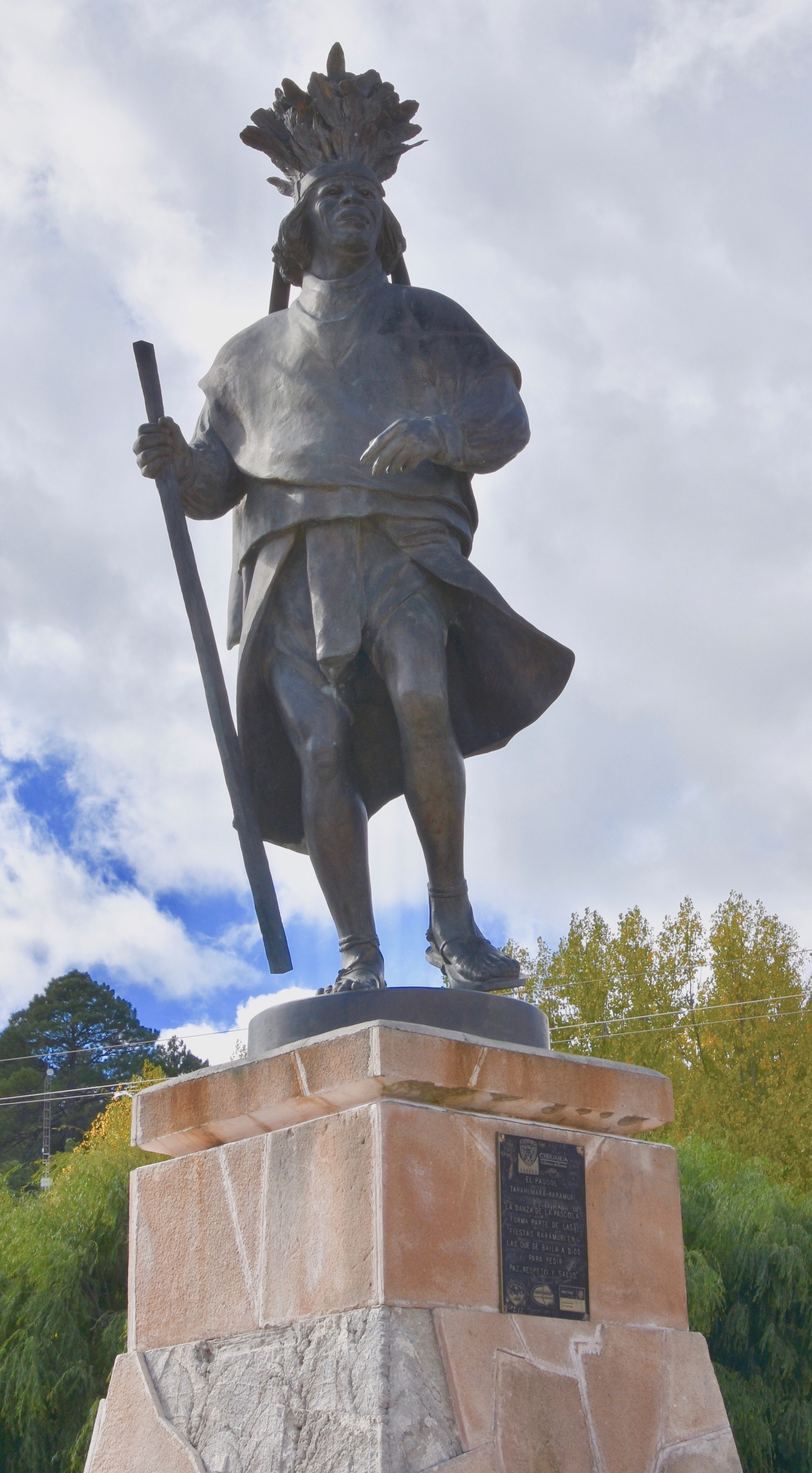
Quinta Mision Hotel, Creel
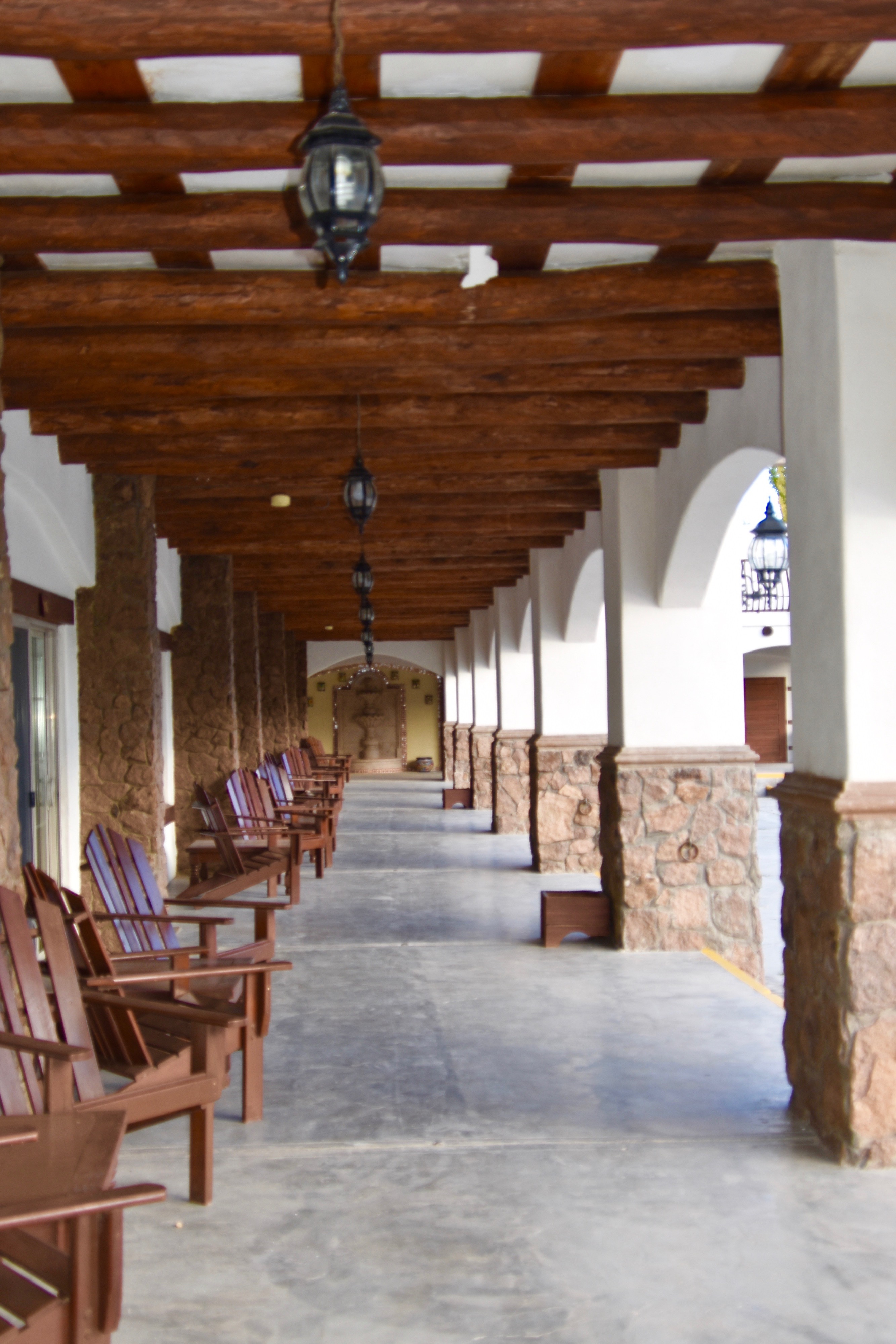
We arrived in Creel after spending the day at the Copper Canyon Adventure Park and pulled into the Quinta Mision Hotel where a tray of fresh margaritas awaited the group. Creel does not have an abundance of accommodations, particularly at the higher end, so I was very pleasantly surprised at size of the rooms which were huge and well appointed. Having seen most of the other places in Creel I would definitely say that this place was the primo spot. Only nit is that the internet only worked in the main lobby and bar and not in the rooms.

After a good meal and a good night’s sleep we spent the next day touring six of the top attractions in the Creel area. Although designated as a magic town, it’s really what’s around Creel that makes it special; the town itself is quite similar to many American small towns that specialize in outdoor activities. Lots of gear shops, hostels, internet cafes and places to get wasted after a day of rock climbing, hiking or fat tire biking. What follows is what we visited that special day in the order in which we visited each place. Each one seemed to get better than the last.
Dona Piedra, Creel
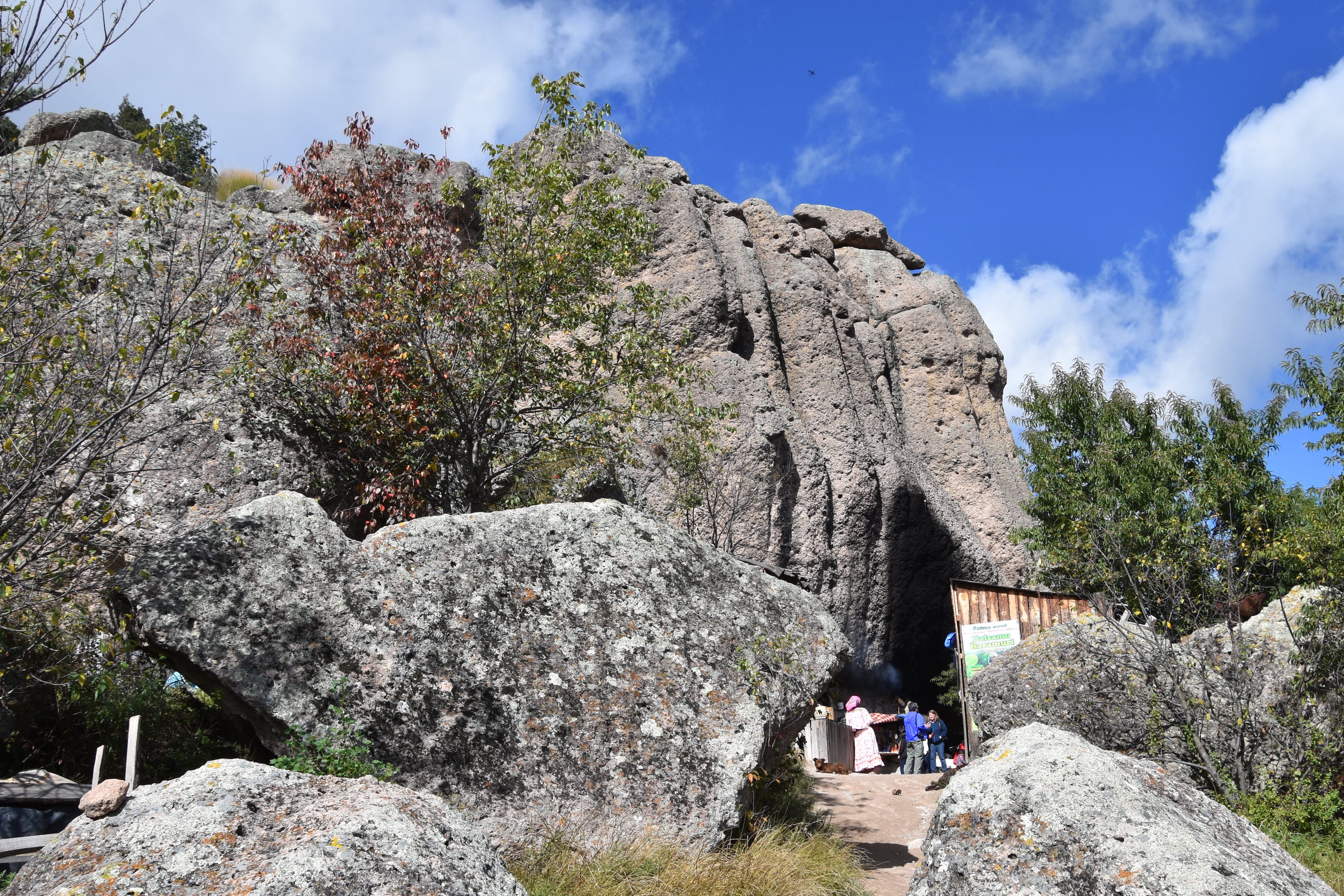
In the last post we visited a Tarahumara family that was still living in the shadow of a small cave in Copper Canyon, however, they had forsaken actually living inside the cave for an adobe structure that was built into the side of the cave. Just outside Creel, in fact not more than a few hundred yards from the Tarahumara statue at the edge of town, a persistent old lady named Dona Piedra (literally the stone lady) still lives inside a cave along with several generations of her family. She doesn’t seem to mind strangers dropping by, although donations are appreciated.
On the way to the cave we passed a number of dogs and children running about, but no adult males. I came upon this monstrously large dog and sensibly abided by the maxim ‘let sleeping dogs lie’.
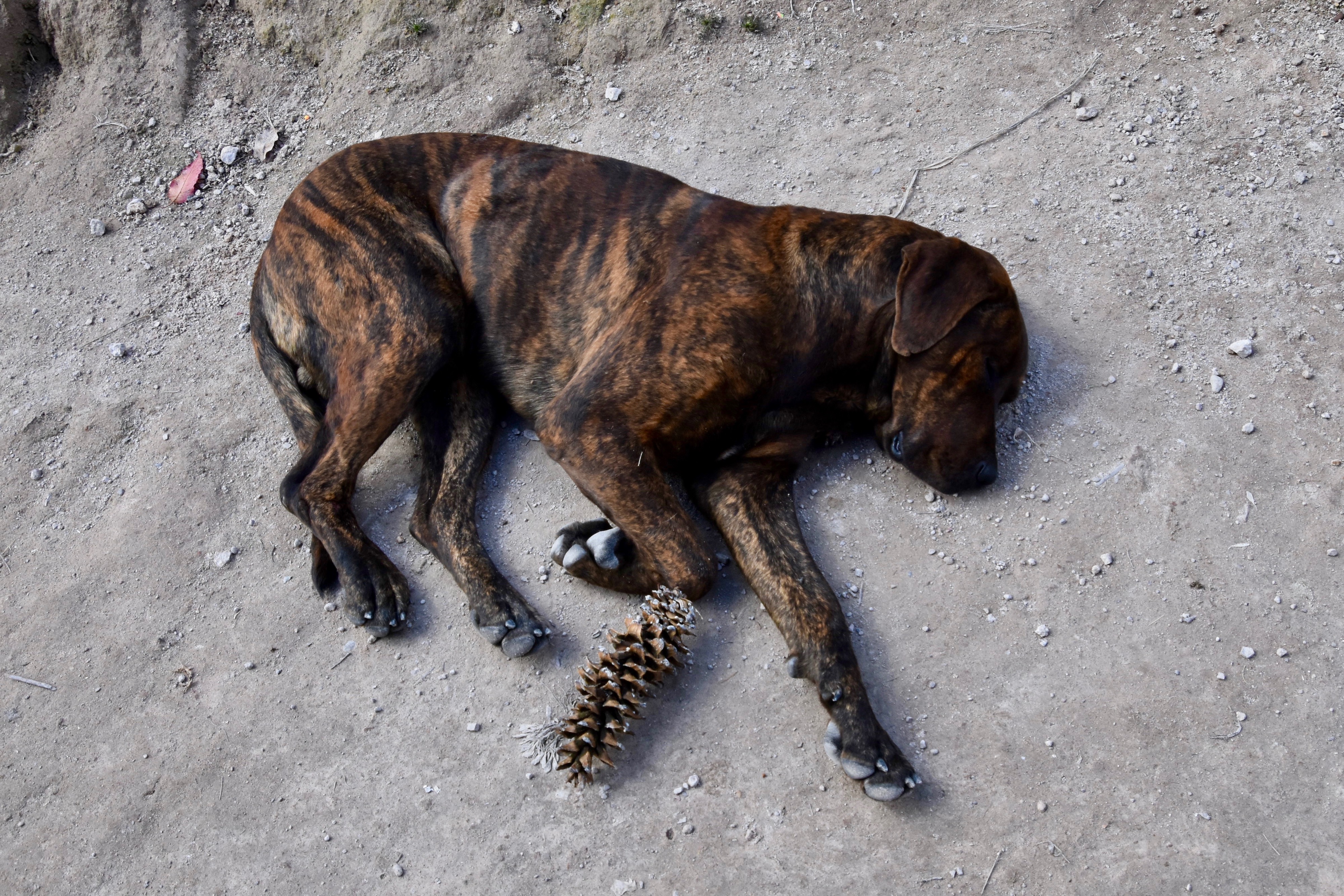
This is the entrance to the cave in which Dona Piedra still lives.
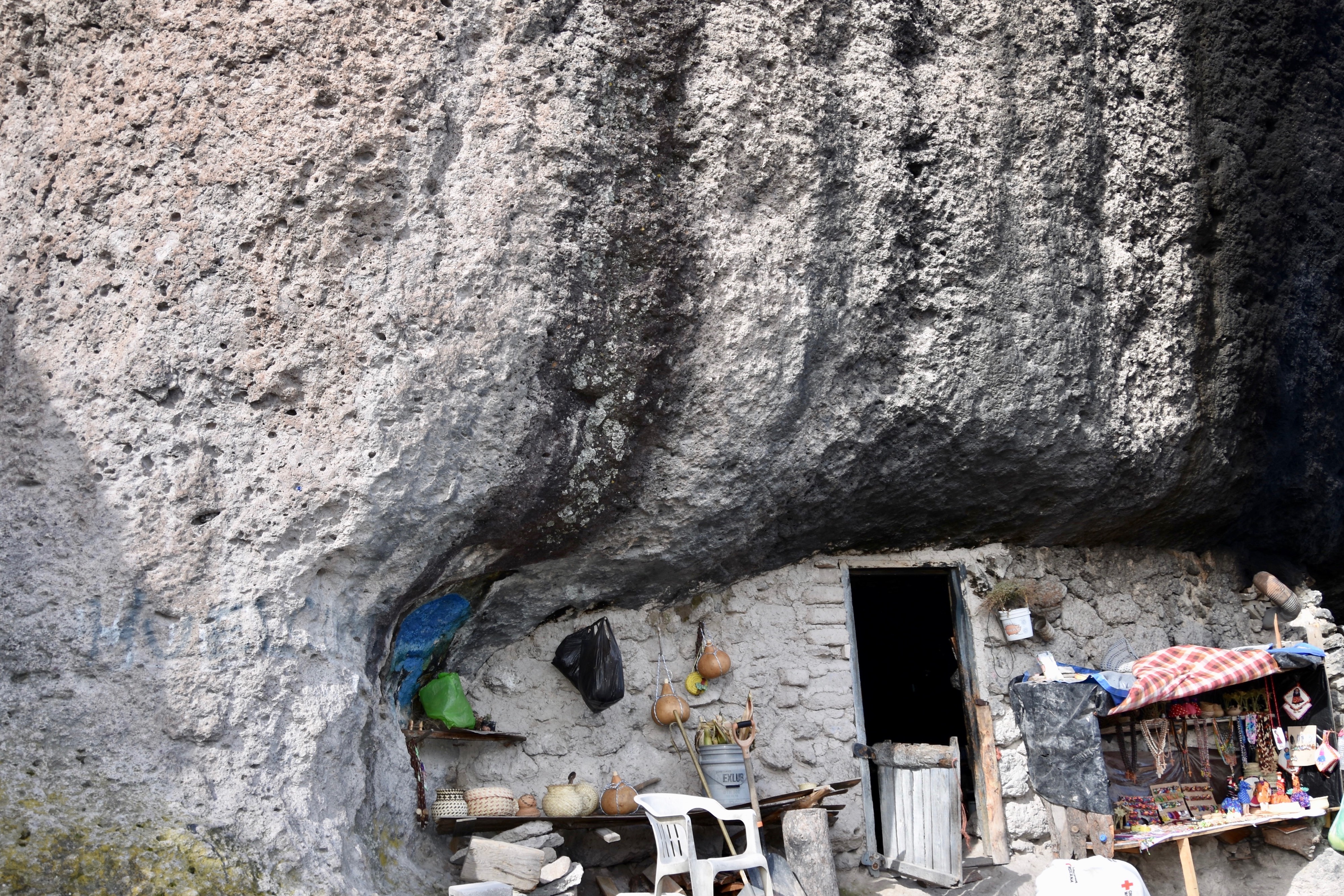
This is the interior where one of the grand daughters was at work making tortillas and doing a good job of ignoring the group of gawkers. Notice the bed just under the crevice at the back. Imagine waking up with a start and knocking yourself out cold by hitting your head on the cave ceiling. At least that’s what I would do if I lived in here.

Apparently the Mexican government was embarrassed by the fact that an old lady and her extended family were still living like troglodytes in the 21st century so they built her a house right next door.
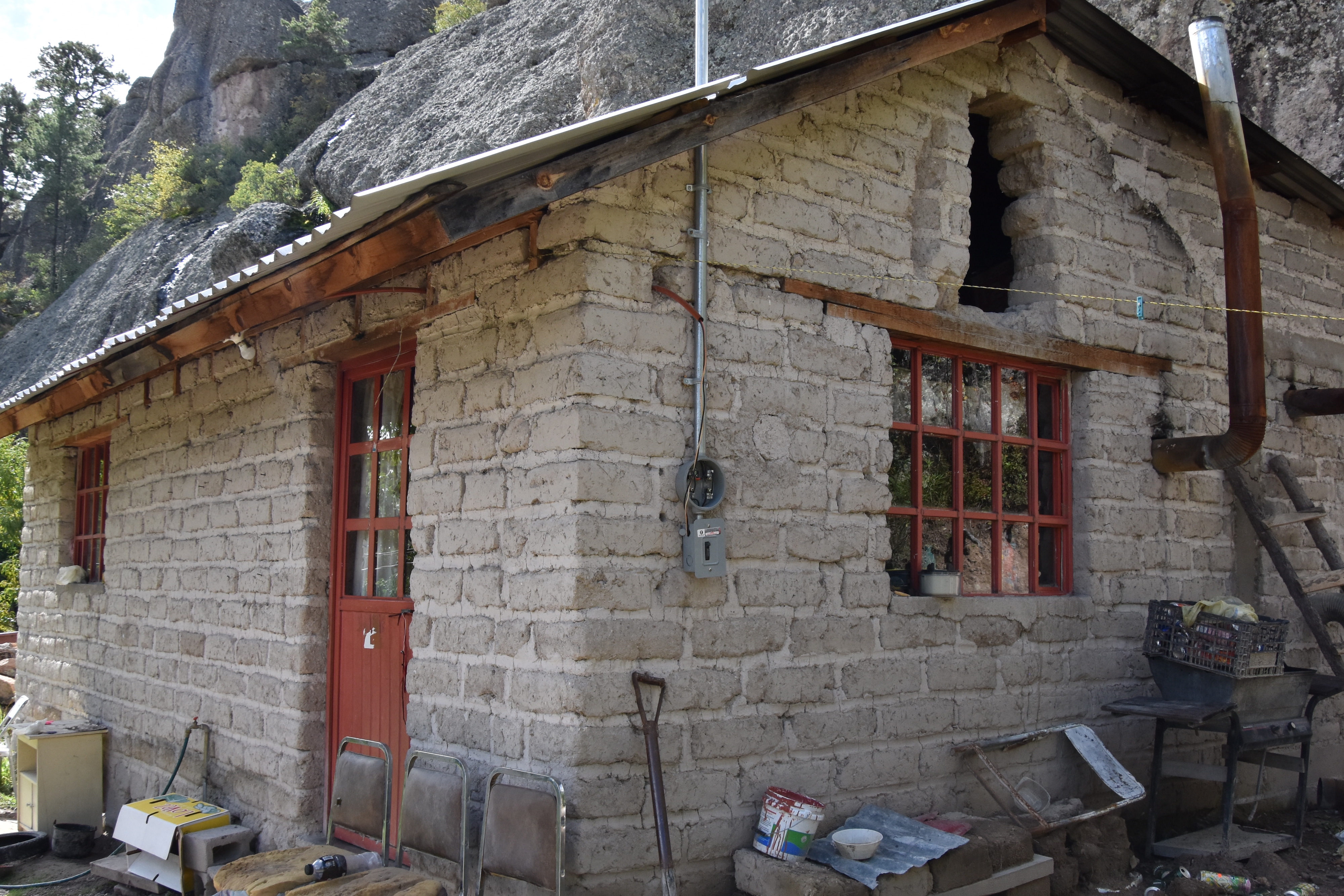
Dona Piedra, however, refuses to leave her cave, but I gathered from the number of empty beer cans behind the new house that the men are not averse to using it. The lesson to be learned from Dona Piedra is that people make their own decisions in life and if they are happy with them, don’t try to change things – it very likely will just make things worse.
San Ignacio Mission
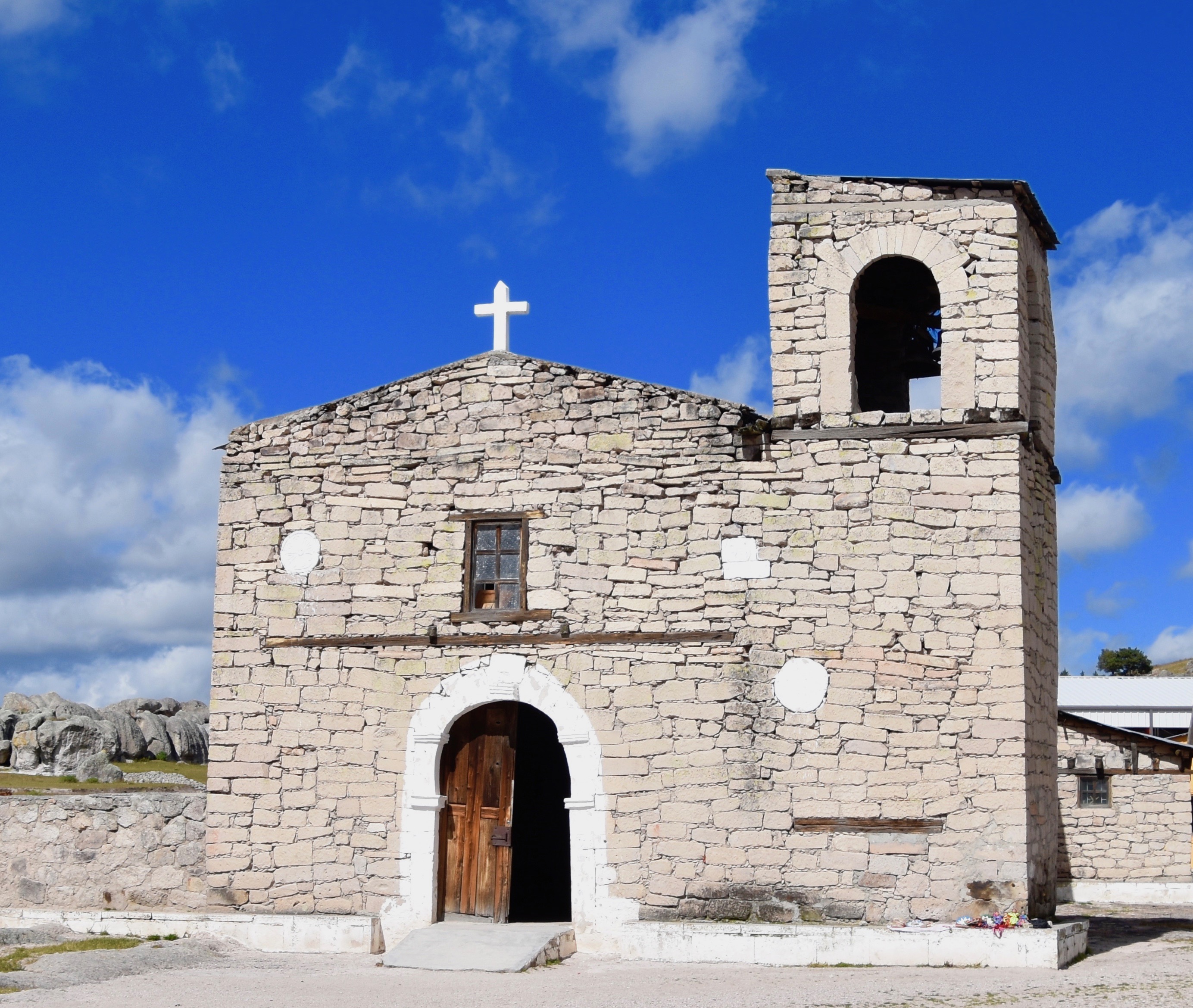
Our next stop was at San Ignacio Mission which is inside a tribal reservation of the Tarahumara. It was built in the mid 1700’s by Jesuit priests who were doing their damndest to convert the Tarahumara to Christianity, despite the fact they were perfectly happy with the religious practices they had been following for thousands of years. In the 19th century during the time of Benito Juarez and his anti-clerical reformations the mission was abandoned only to be rebuilt in the 20th century once the church and state of Mexico had come to an enduring, if sometimes uneasy truce.
Today it is still in use, but does not have a resident priest. He has to be brought in from Creel apparently.
The interior is plain with none of the over the top Mexican baroque of more wealthy communities. That’s St. Ignatius Loyola, founder of the Jesuits, presiding over matters.

What I found more interesting than the mission, although it was quite interesting, was this residential school which is right beside it.

Indigenous residential schools are a topic of great debate, derision and consternation in my home country of Canada, as well as the United States. The idea of removing children from their families and forcing them to use English instead of their native language, wear western garb and generally give up their traditions and assimilate into ‘civilized society’ is now regarded as a terrible historical mistake, not matter what the intentions of the people involved. I do not agree that it amounted to ‘genocide’ as a recent Canadian government commission concluded, but it was conducted in a manner that was just plain wrong.
So what is the Mexican government doing today by still having residential schools? Don’t they know it’s unacceptable? Well actually, they are doing it the right way and it’s not the Mexican government behind it, but the Tarahumara people themselves. There is a realization that for many people, education is the best and probably only way, out of poverty. That being said, many Tarahumara don’t consider themselves poor or their way of life backward and needing change. For that reason many Tarahumara children never go to school. However, others do think education is important even though they realize that education may well result in their children not returning to the family home, but seeking a life outside the traditional community.
So the rules of this residential school are these. It is entirely voluntary. It is run by the Tarahumara. Lessons are taught in the Tarahumara language and Spanish is taught as a second language. With these three simple principles, the residential school becomes a place of enlightenment and not a place of forced confinement.
Okay, enough with the social commentary, time to see some really cool rocks.
Valley of the Monks
Continuing on from St. Ignacio Mission we headed deeper into the Tarahumara reservation on some pretty sketchy dirt roads that tested the suspension of our guide Adrian’s van. However, the jostling was more than worth it when we arrived at the Valley of the Monks, a series of rock formations that resemble, you guessed it – monks.
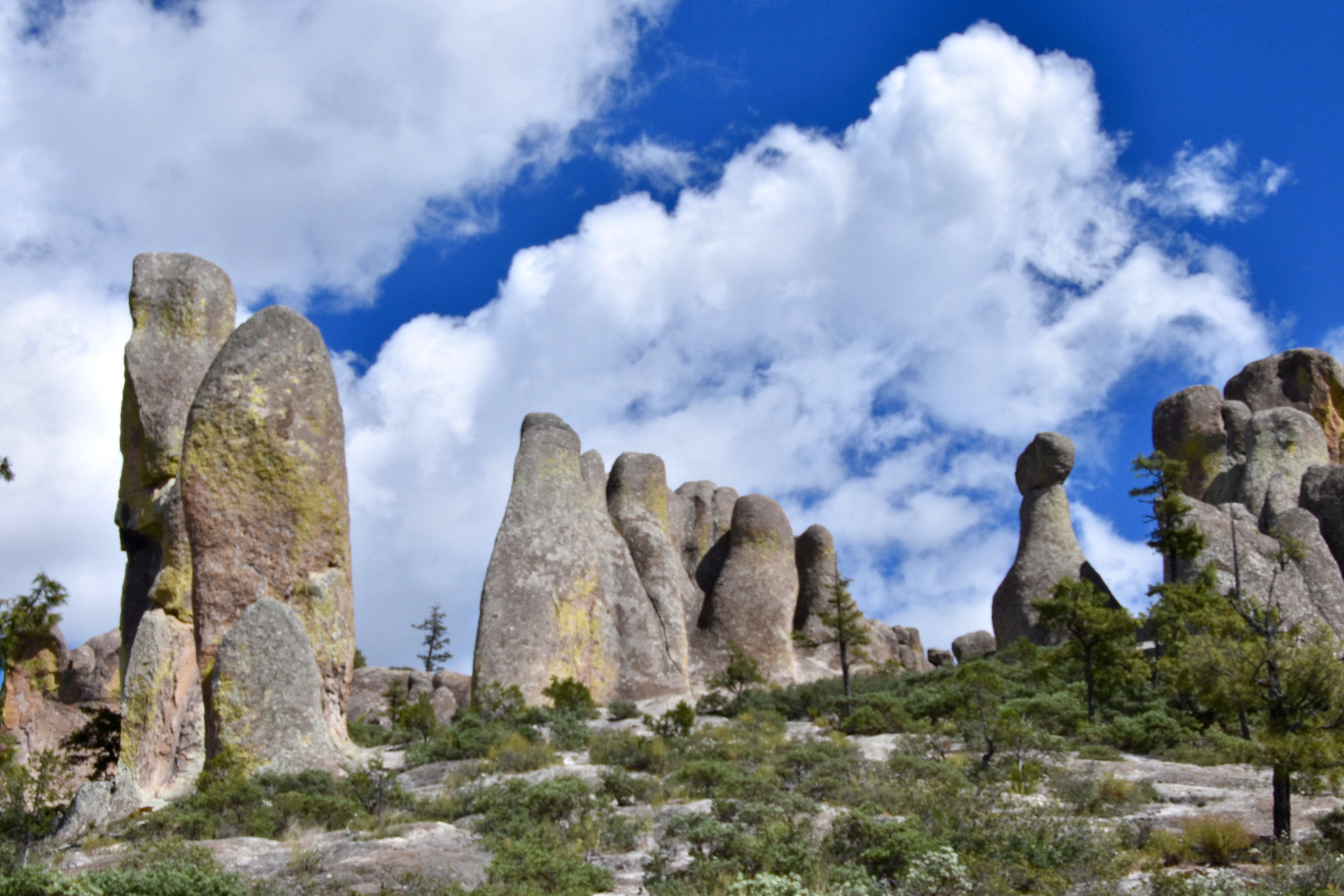
However, Adrian said that according to Tarahumara tradition these were the petrified remains of evil giants who came to take way the Tarahumara children, but were defeated by the forces of good. Frozen monks, frozen giants – either way they a bloody cool and you’ll definitely want to get a picture with them.
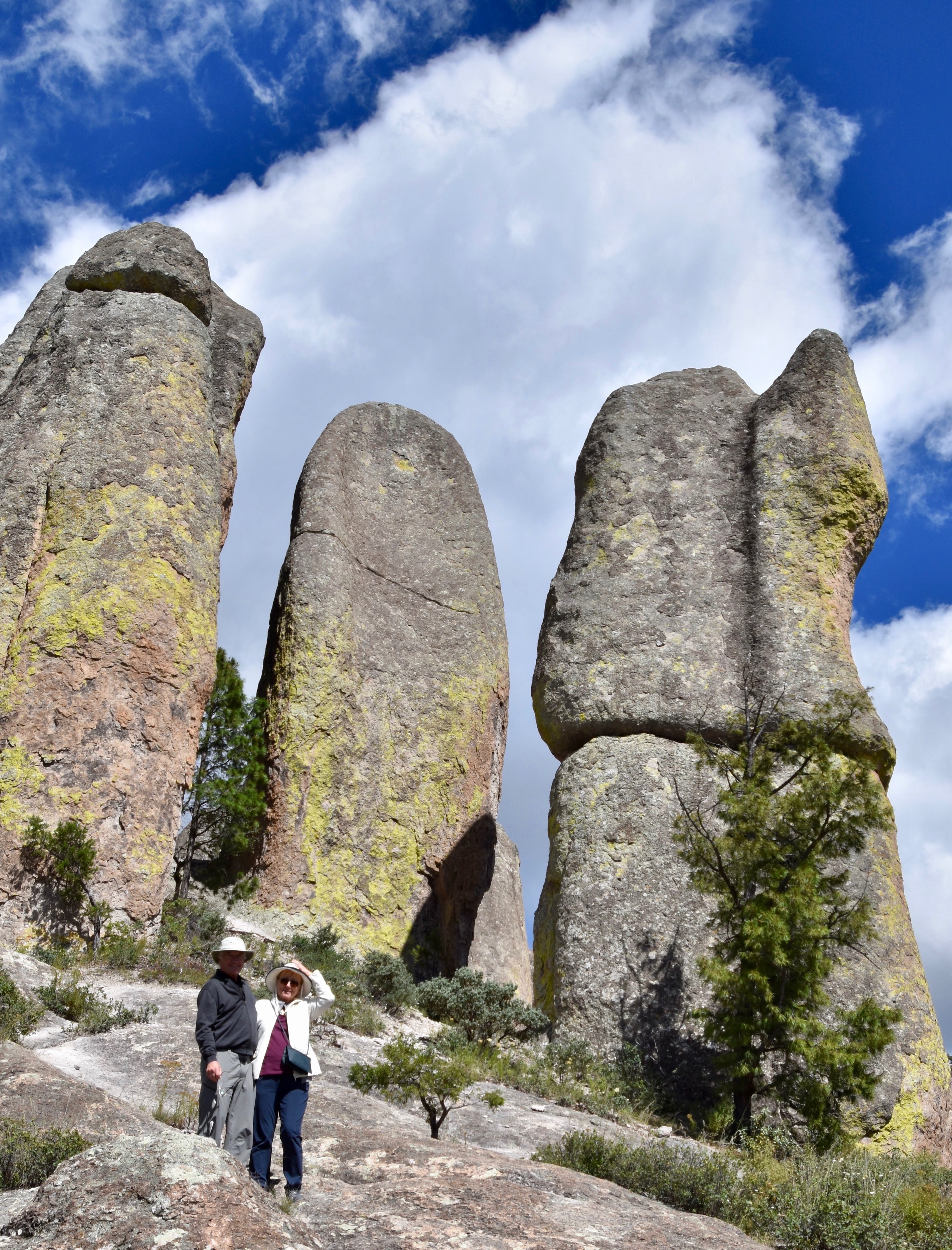
You’ll probably also want to make a video which will look something like this.
One final shot before leaving. This is a place where you will want to take one photo after another and I had to chose these few from among many.
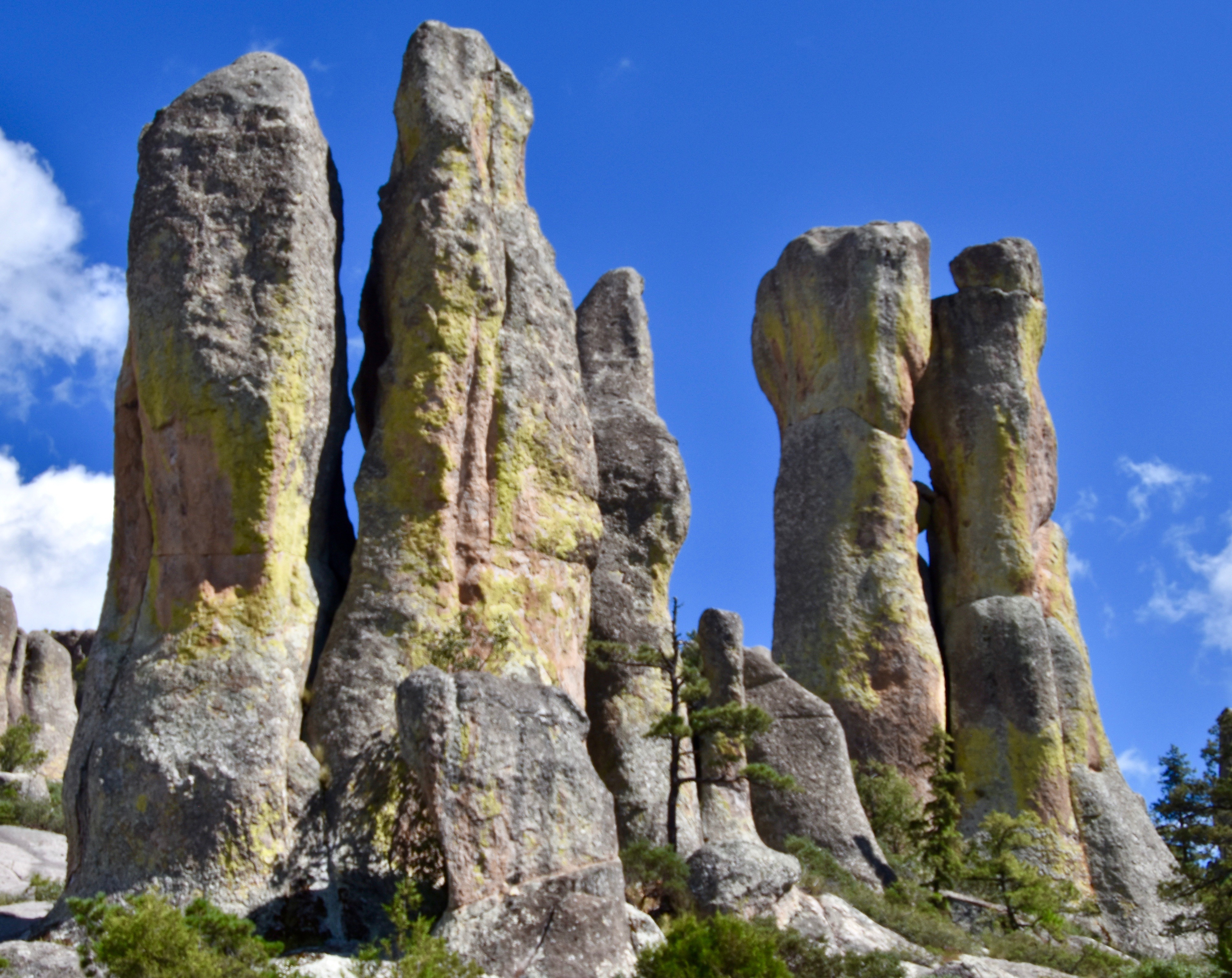
A Frog & Mushrooms
Monks aren’t the only things petrified in the area around Creel. Our next stop, still inside Tarahumara country was to see this rock formation that can only have been a frog.
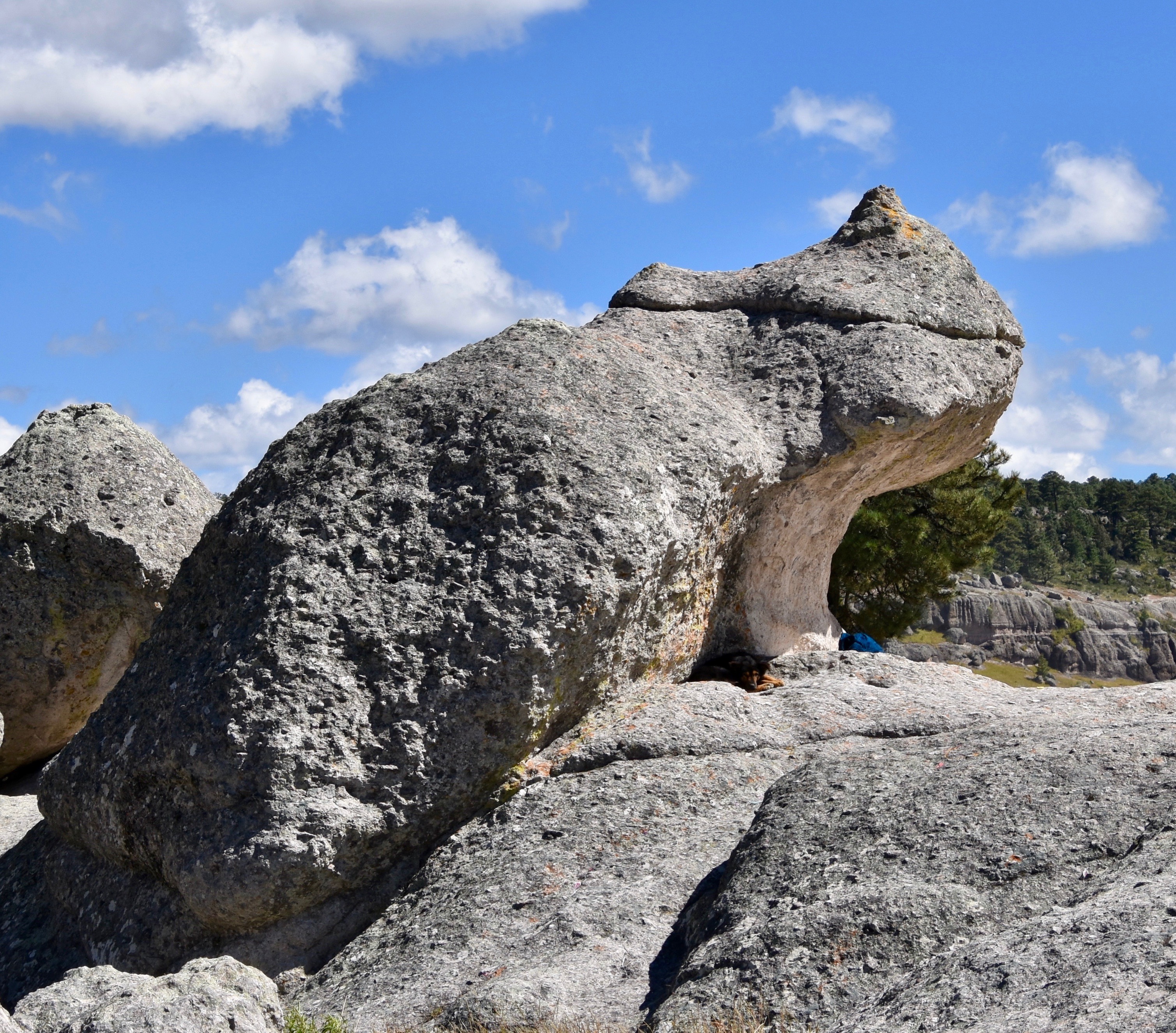
A short distance away was a field of mushrooms, but not ones you would want to eat.
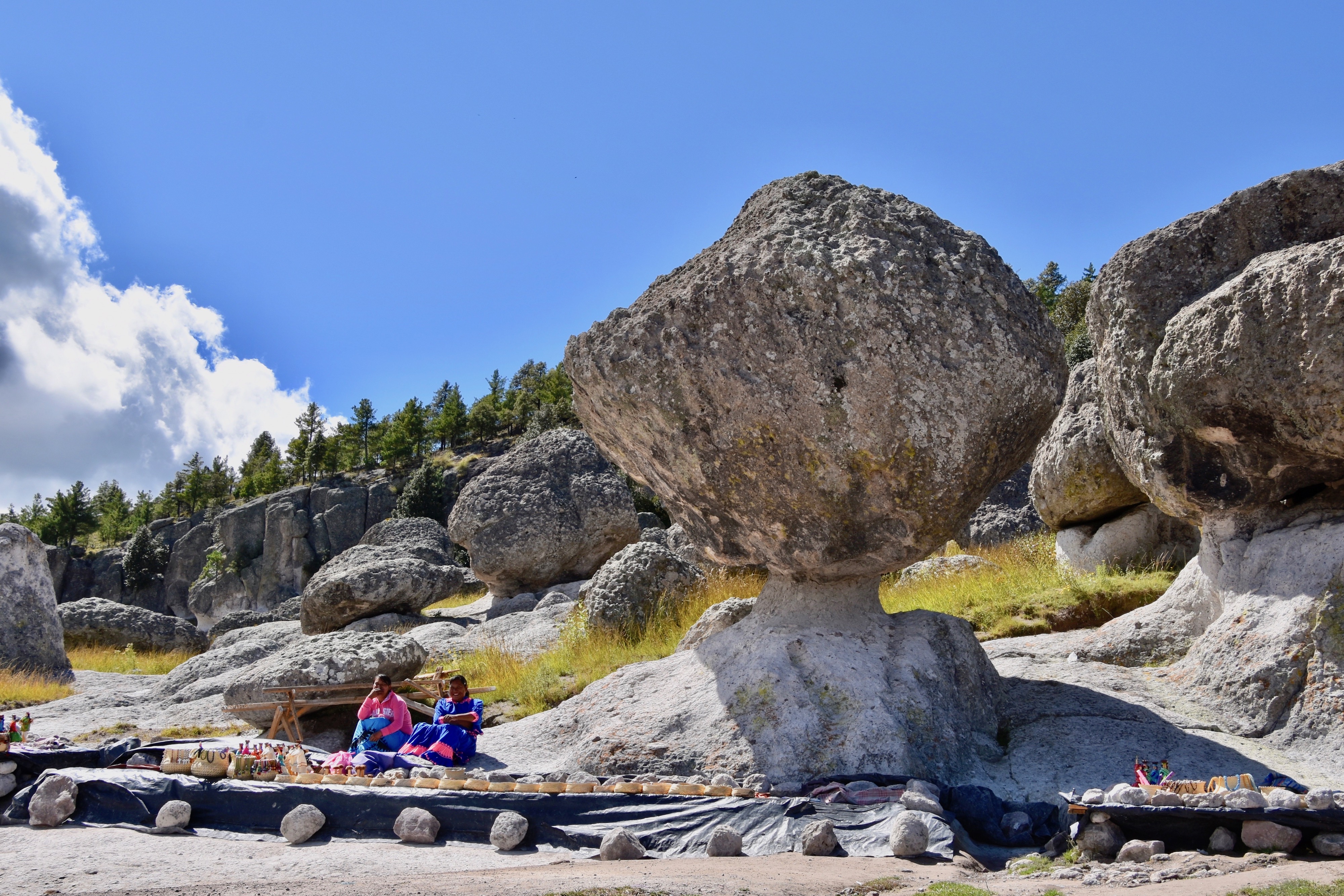

There were a number of vendors at the mushroom rocks including a woman selling burritos out of the back of her car. Adrian bought a burrito, not to eat, but split among the dogs who quite obediently lined up in a row and waited their turn while Alison took their picture.
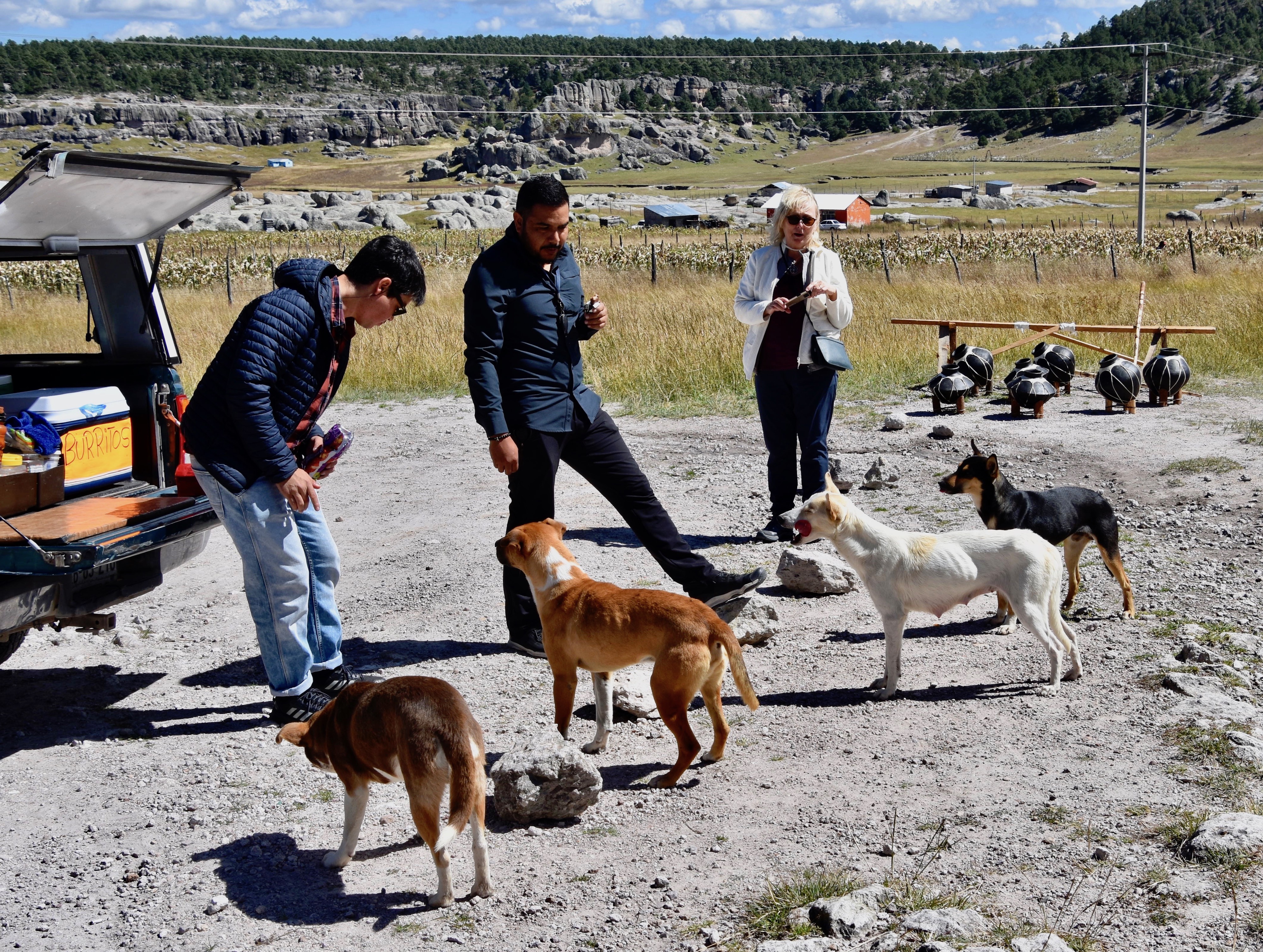
Okay, we’ve seen the miracles in stone and a few other interesting things, time now to see one of the Creel area’s miracles in water.
Cusarare Falls
Deep within the piney forests of the uplands south of Creel there is an amazing waterfall on the Cusarare River that was our next natural wonder in this area that abounds in them. We had stopped for a late lunch at the Cusarare River Sierra Lodge which is an eco lodge with no electricity and few amenities other than pure peace and quiet and great hiking opportunities. From here there is a three kilometre (two mile) walk to the falls or as most opted to do, you could get within 700 metres by taking a very rough tract on the other side of the river.
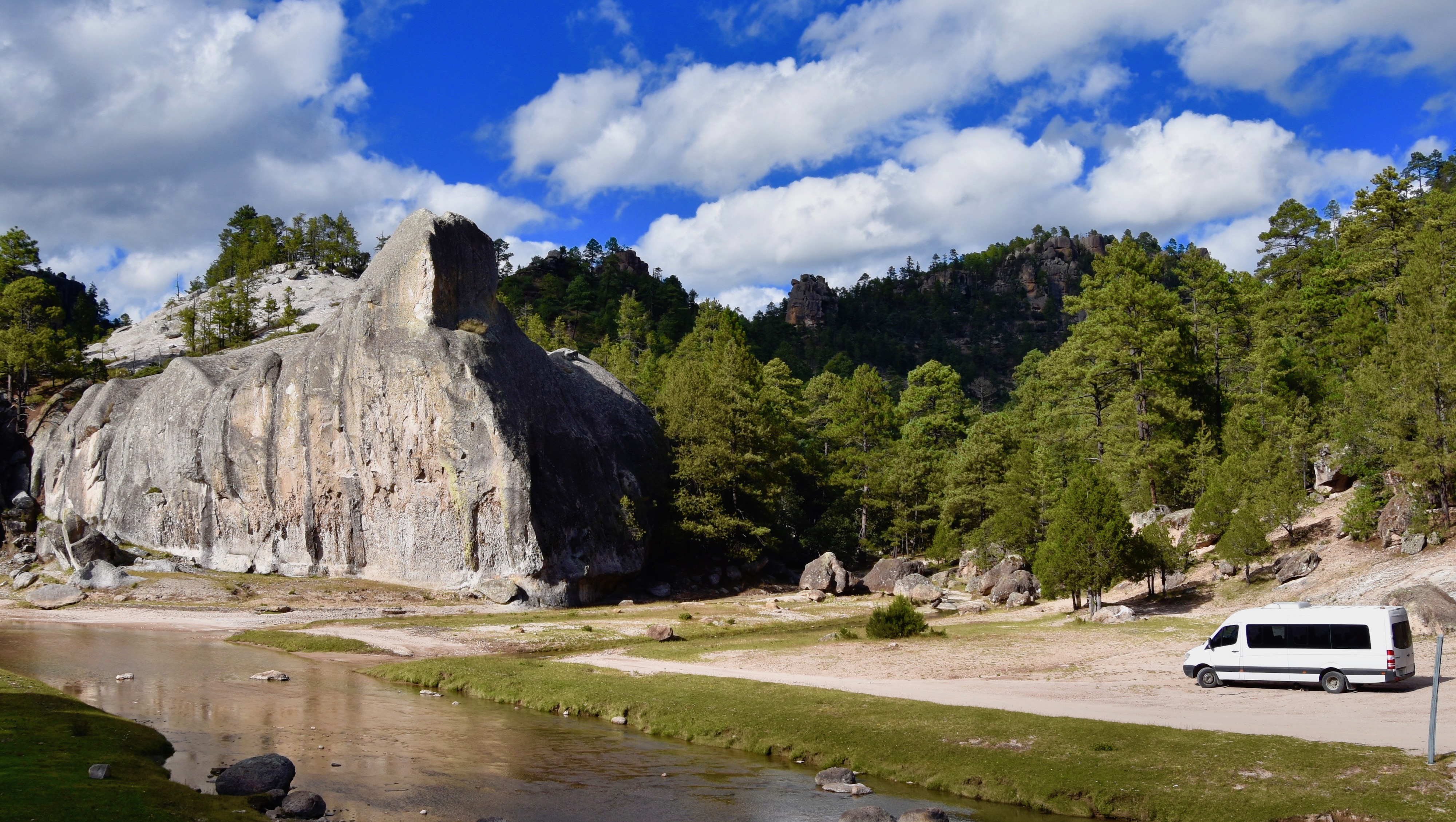
We than crossed the river once again on this suspension bridge.
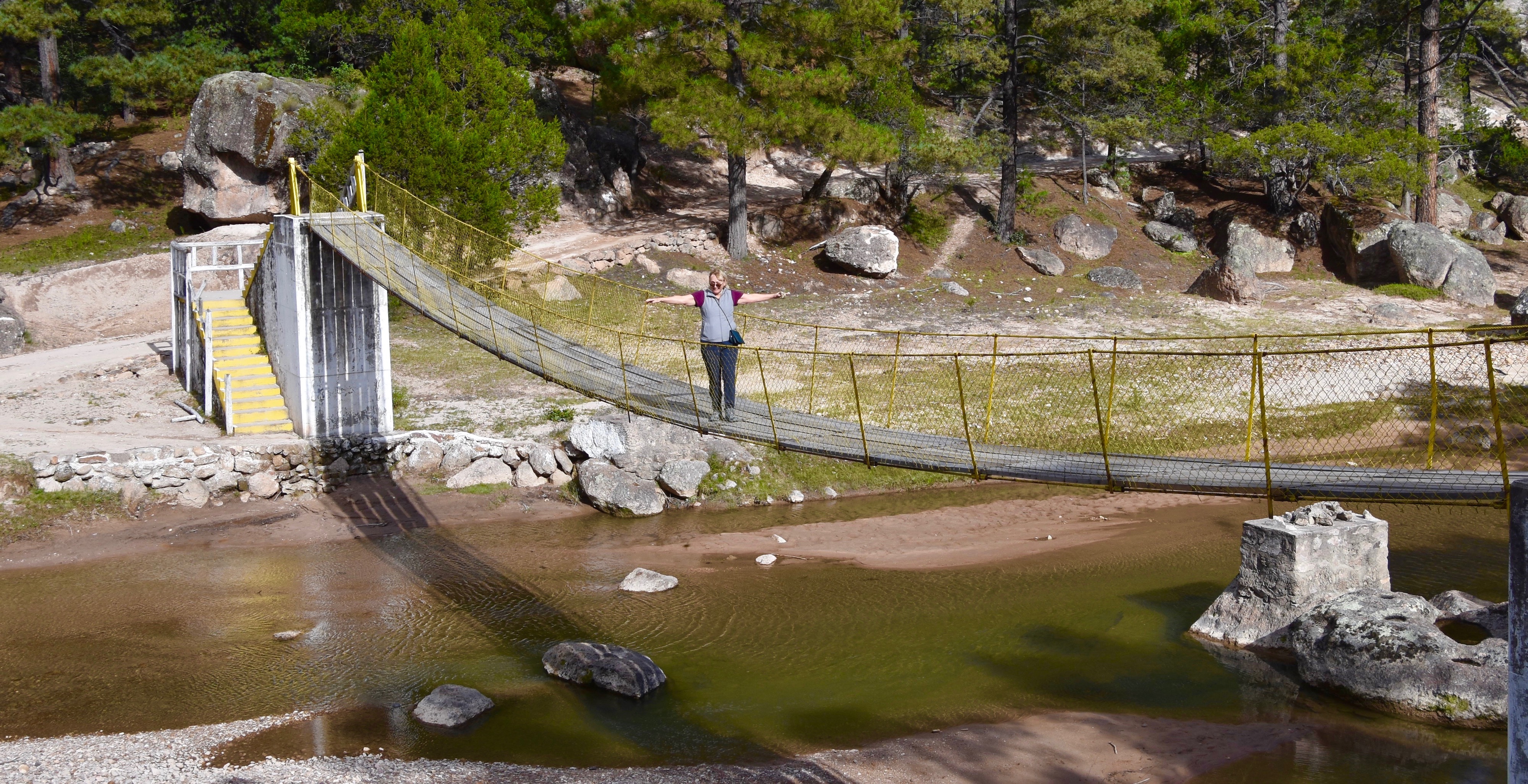
The views from the bridge were exquisite even if we weren’t going to a waterfall.
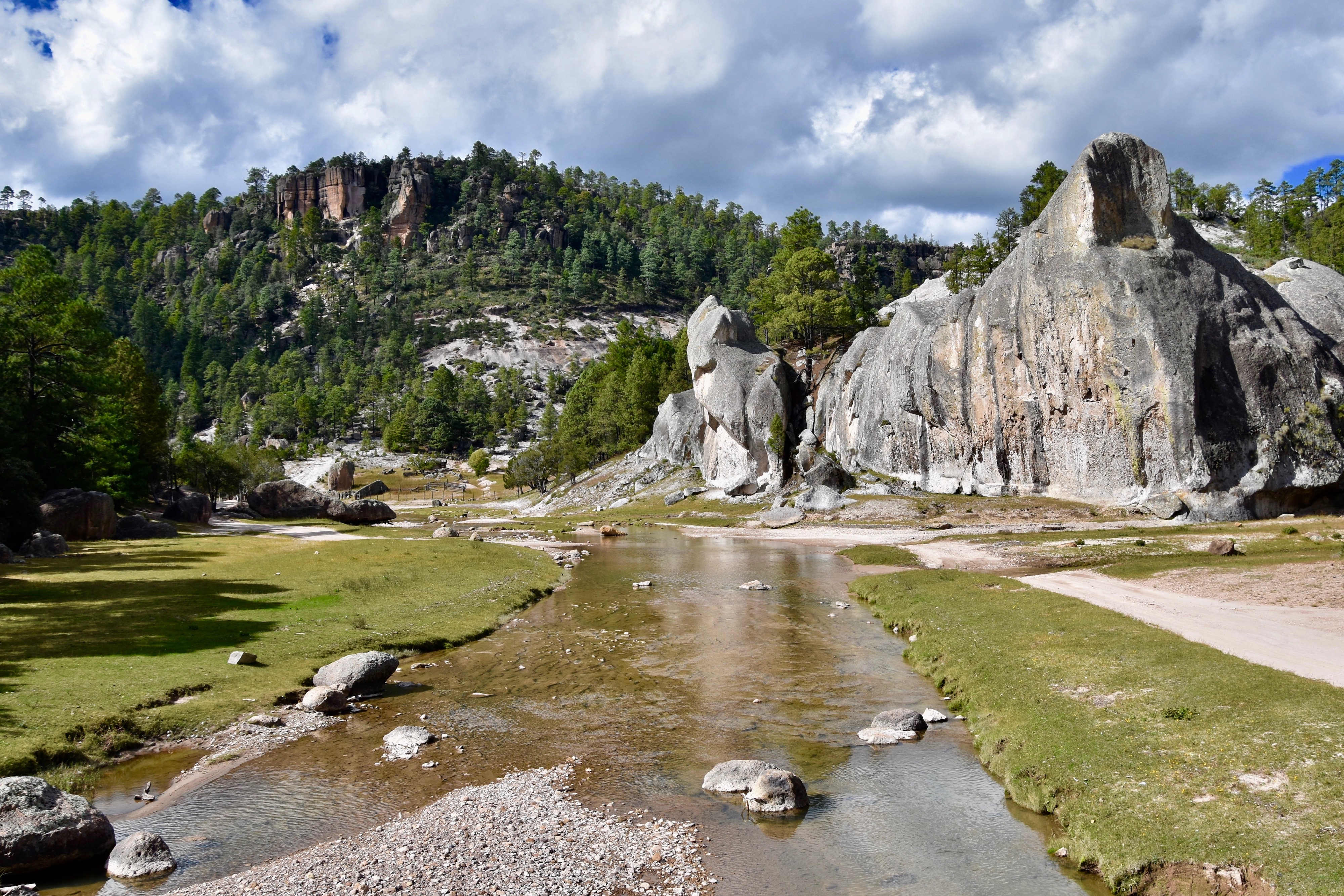
The walk to the falls from where the van was parked is a gentle climb which should be doable by all but the least fit. About two thirds of the way there you run into a string of Tarahumara vendors selling their handicrafts. They are not aggressive and I resolved to buy a handwoven basket on the way back. However, I did pick up a guide without intending to. A small Tarahumara girl of about five in a bright orange dress started following me without saying a word. When we reached the top of the falls she scared the heck out of me by standing and leaning precariously over the rail. I probably shouldn’t have encouraged this type of behaviour by photographing her, but that only occurred to me later.
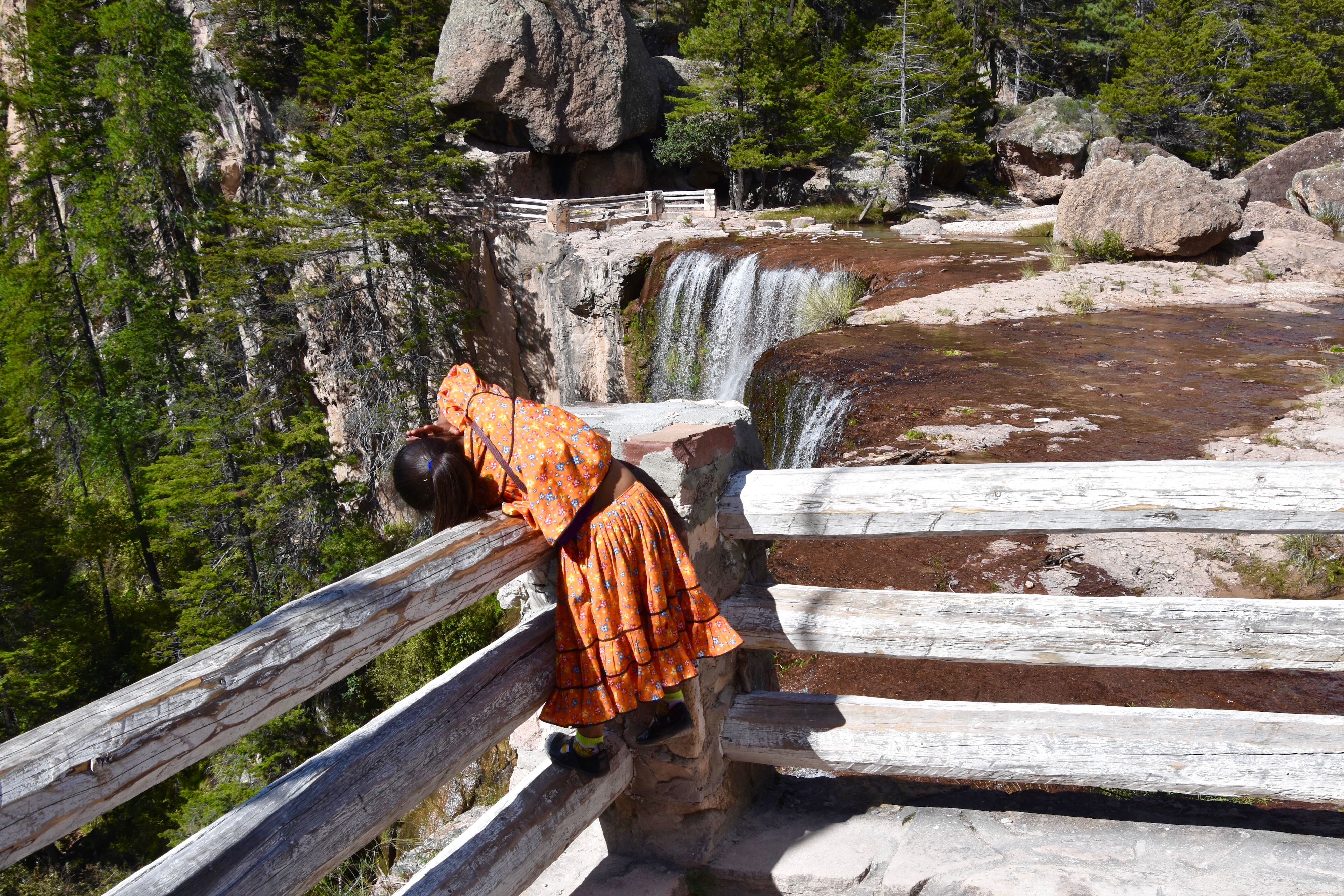
My guide then almost sprinted down the 240 steps to the bottom of Cusarare falls which is where you want to be to get the best persepective, although this one from the top was pretty darn good.
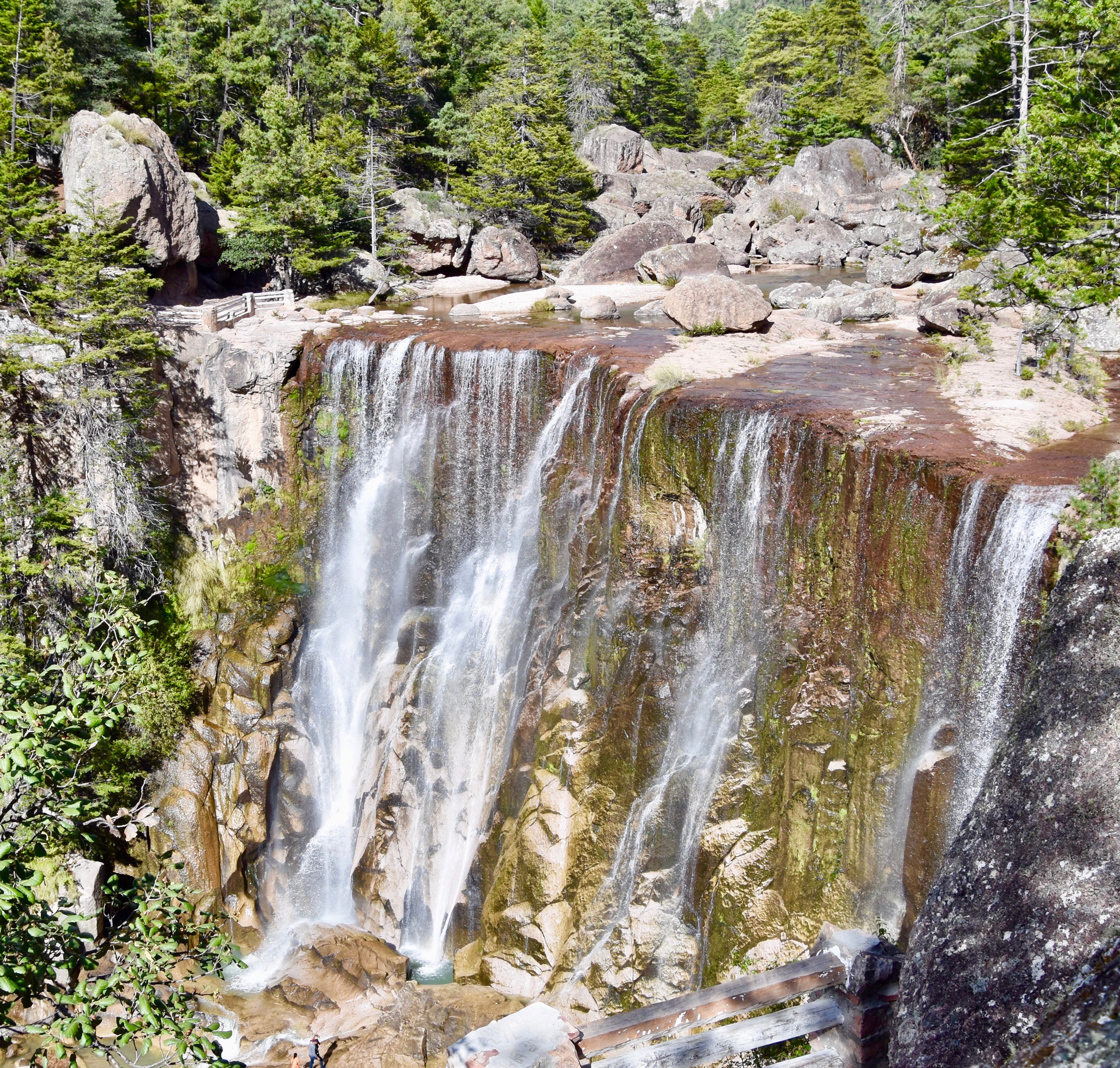
Reaching the bottom you get this amazing view looking up.
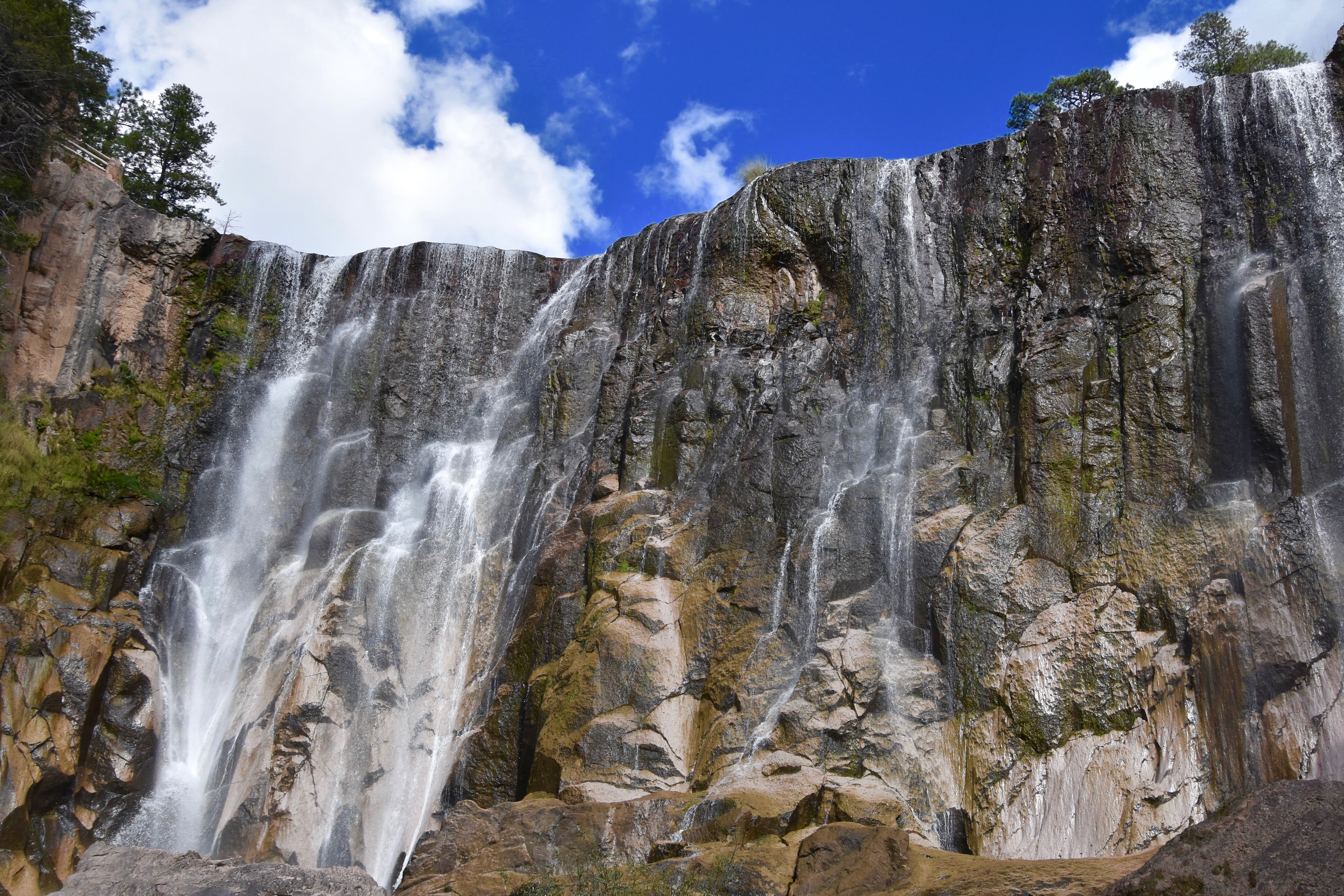
Better yet, how about a video. Ignore the fact I called the Tarahumara the Tamahumara.
This was also a good place to take a portrait of my enterprising young guide. I gave her ten pesos which she secreted in a tiny purse she pulled out of somewhere and she was off to look for her next customer.
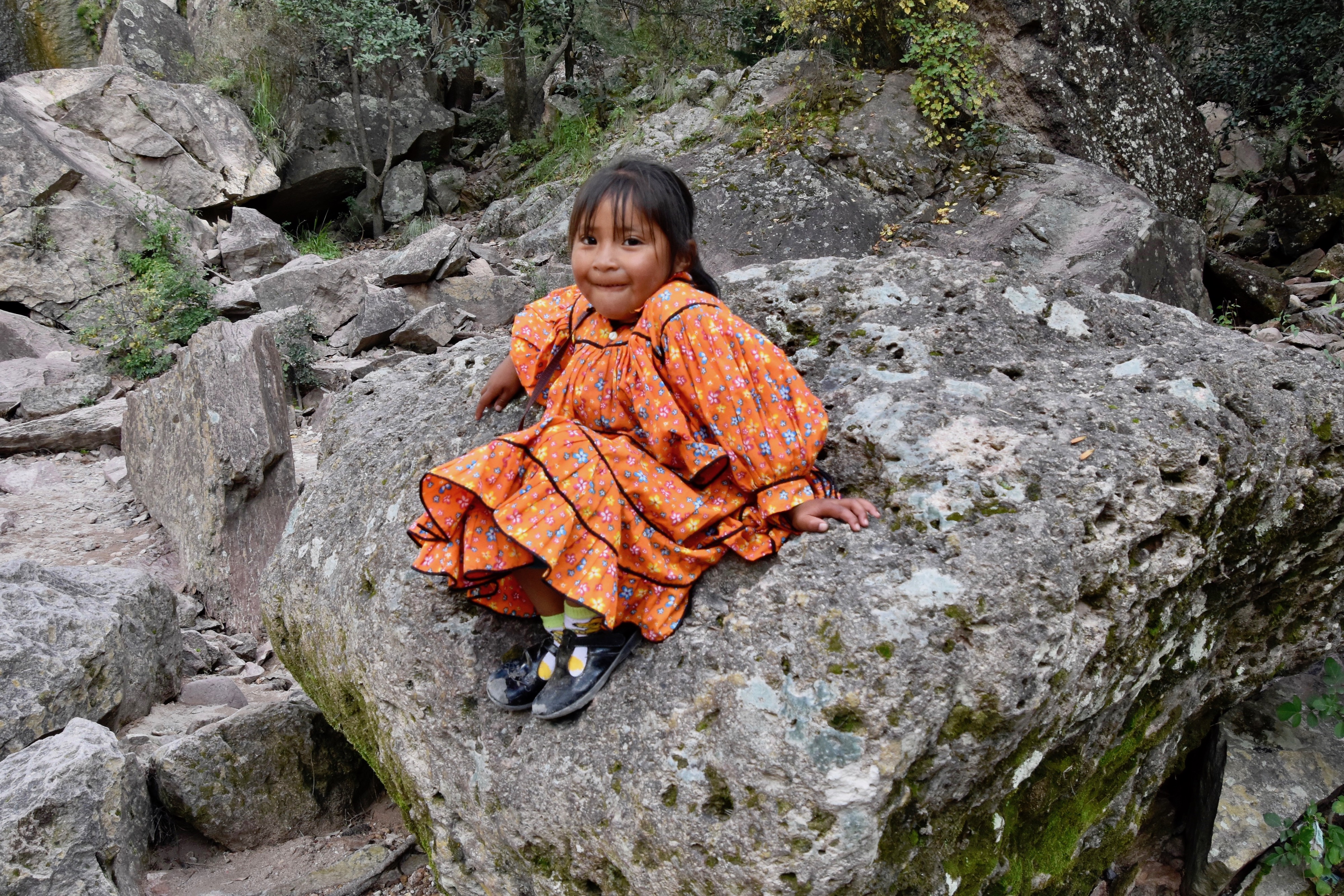
The climb back up was not as demanding as I expected and I met Alison at the top who was just arriving, having taken the longer route in from Sierra Lodge.
On the way back as promised we stopped and bought a small Tarahumara basket for an asking price so low that to try to bargain the seller down would have been insulting and ignorant.
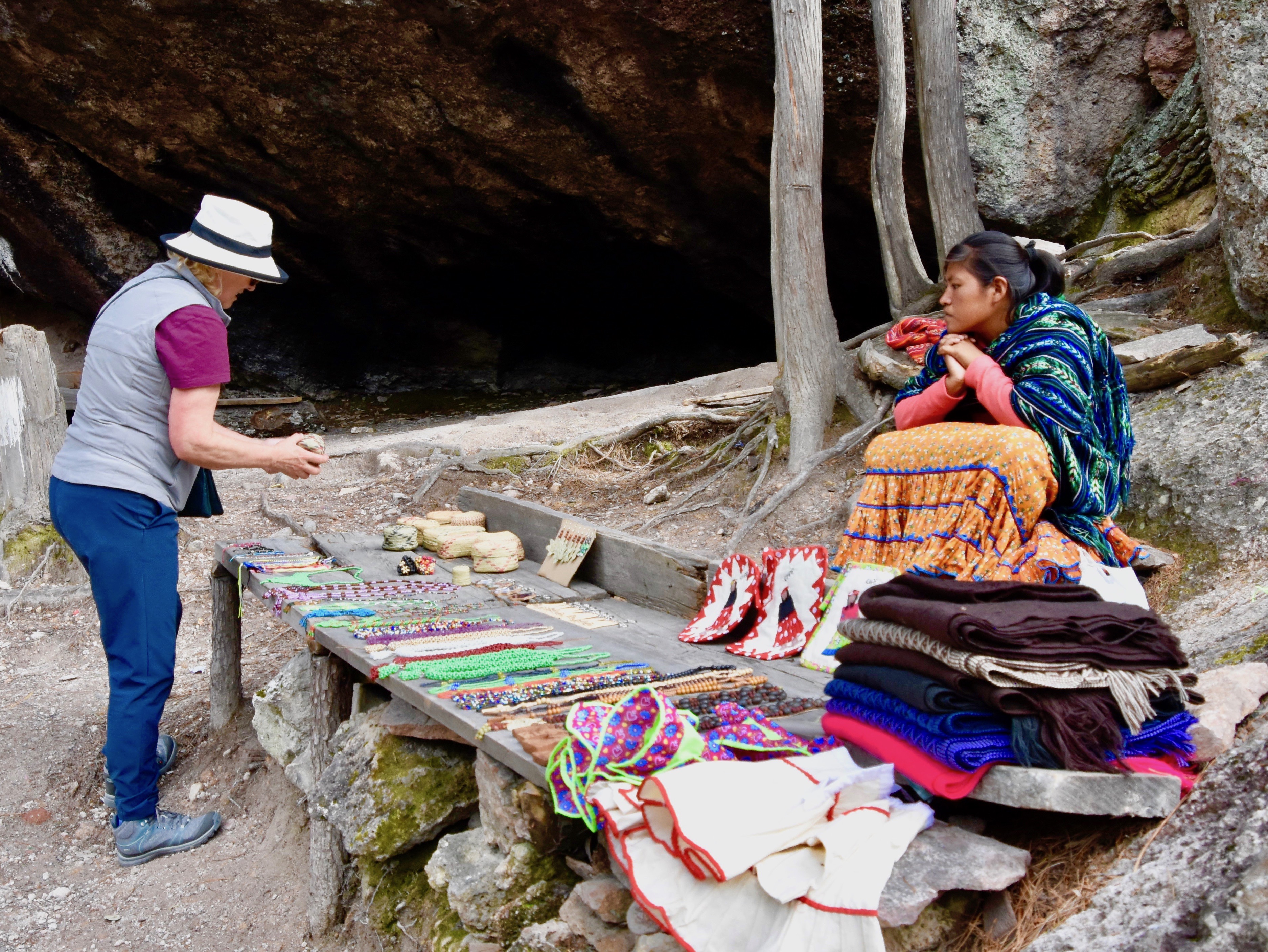
This had been a long day of visiting many wondrous places and most were more than ready to return to Creel which we did with one final stop at the crystal clear waters of Lake Aracenko not far from the town.
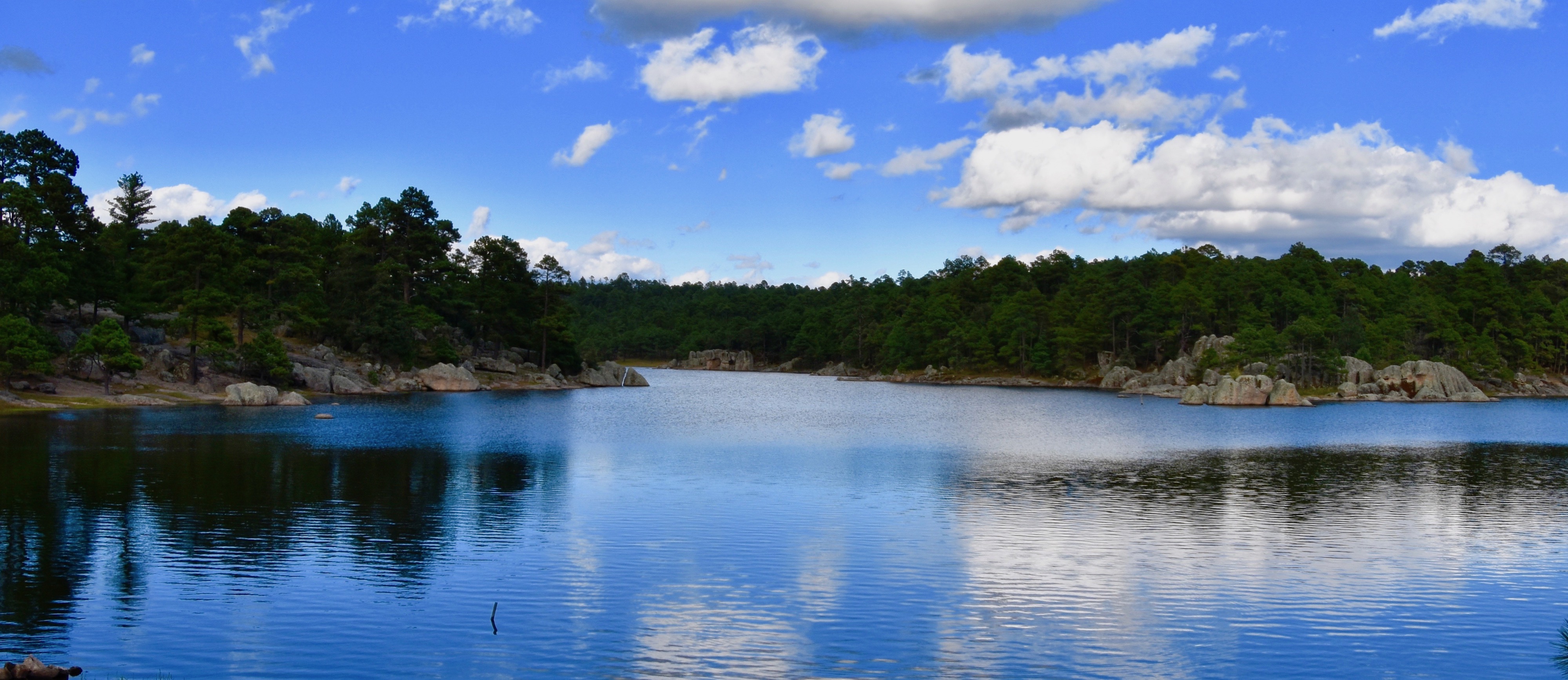
This was the end of day three of one of the greatest SATW pre-trips I have ever been on. No one should ever pass up a chance to visit the Creel area of Chihuahua state, Mexico. We will now head back to El Paso, but I will be returning to a completely different part of Mexico in a few months. Join me on a visit to the fabled resort city of Puerto Vallarta.

